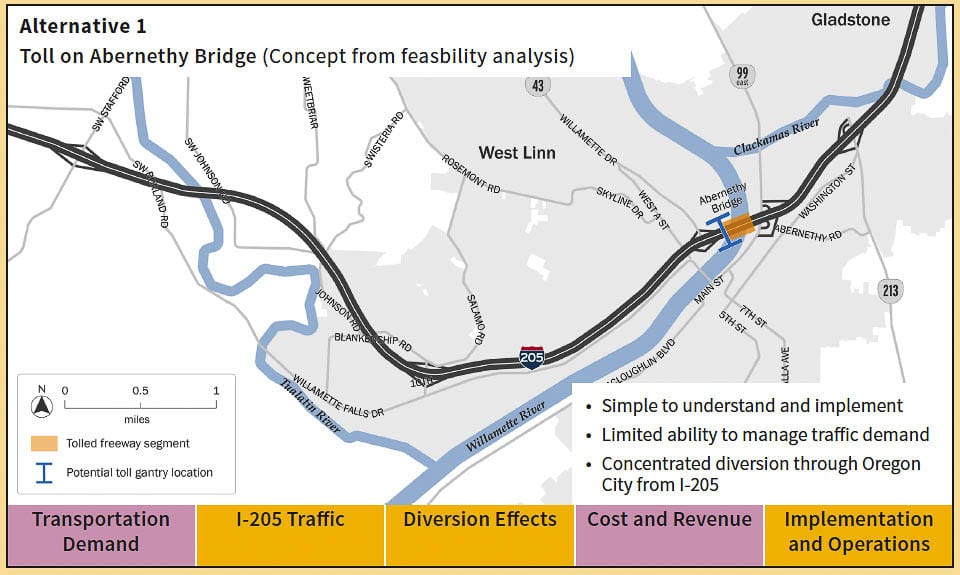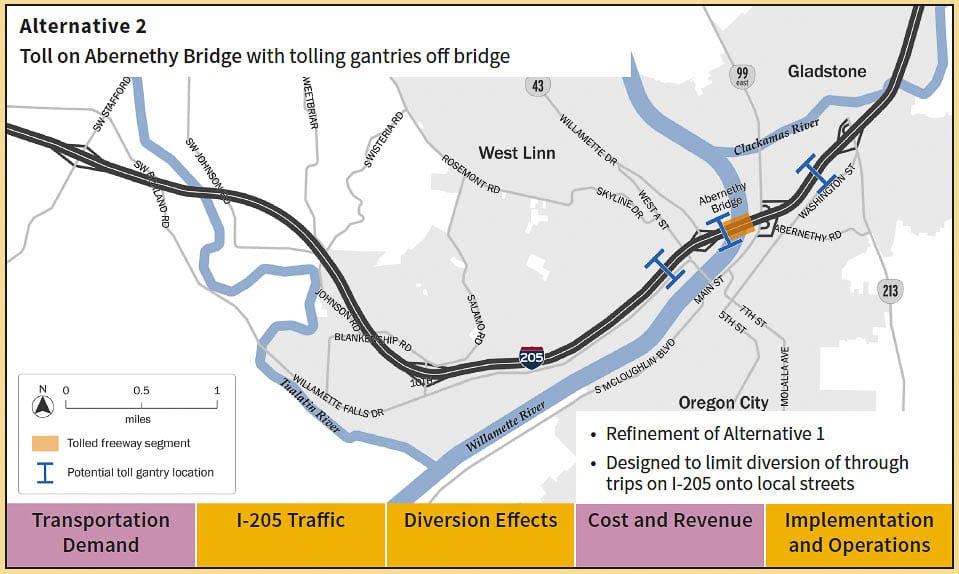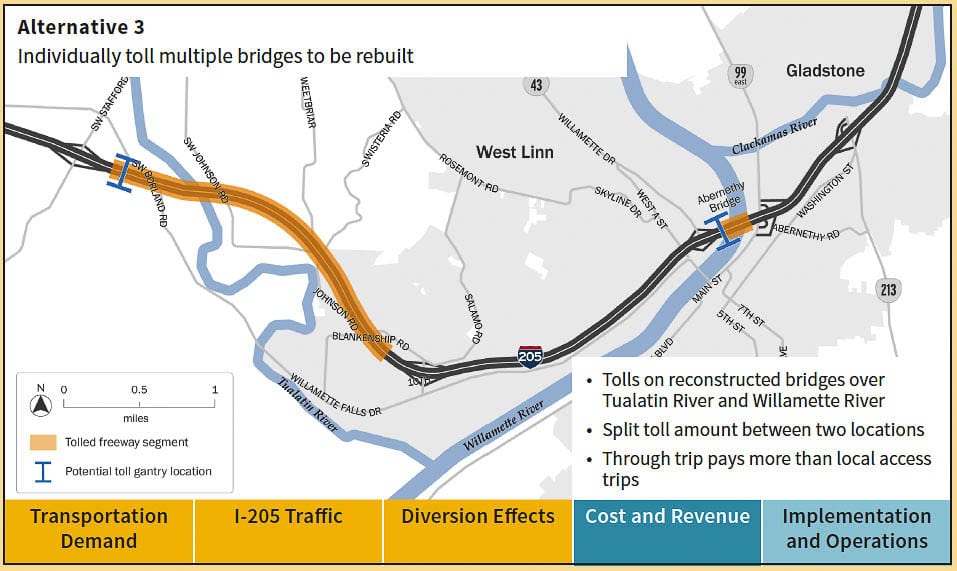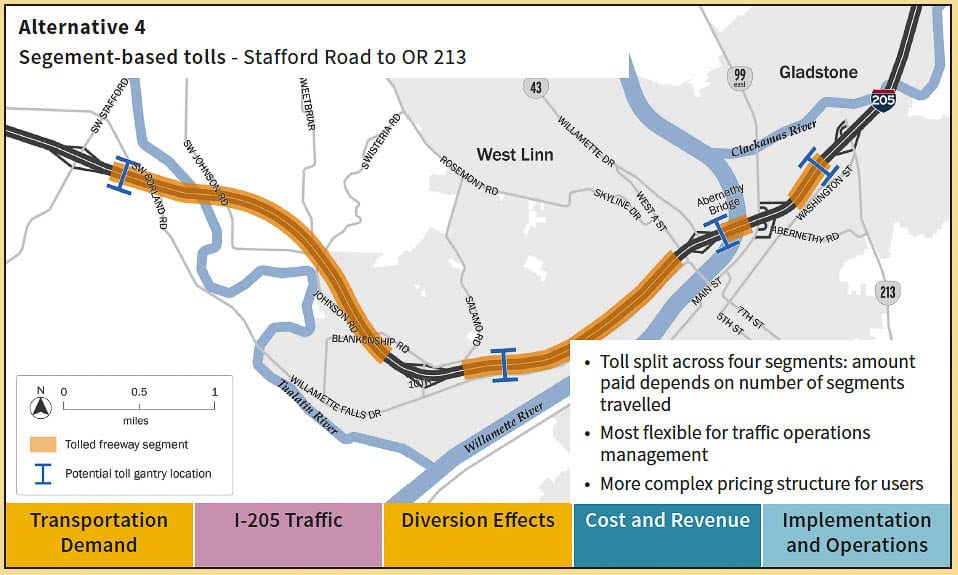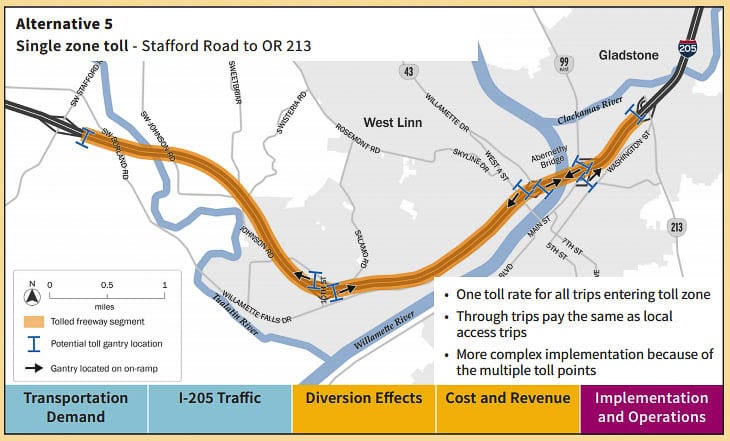Five alternatives, traffic diversion, congestion relief, fairness and equity of tolling all topics for citizen input
The Oregon Department of Transportation (ODOT) period for citizens to comment on the five alternatives proposed for tolling I-205 ends Oct. 16. The public comment period was extended due to the wildfires last month.
This issue should be of interest to Southwest Washington citizens because Oregon House Bill 2017 mandated the study of tolls, beginning “at the border” with Washington, for both I-5 and I-205. There are over 70,000 Southwest Washington residents who (pre-COVID-19) commuted to Oregon for work. Ultimately, ODOT officials have indicated a desire to expand tolling to all area freeways including I-5, I-205, I-84, I-405, Hwy 26 and Hwy 217.
An initial “test” area is proposed for I-205 in the area of the Abernethy Bridge. ODOT is also working on a second test area of I-5, from around Going St. in North Portland to around Multnomah Blvd., south of downtown. The I-5 tolls would be implemented after I-205 tolling has begun. The expansion to the full freeway system will come later.
A detailed report on each of the five I-205 options can be found here. Not discussed much is a “no build” option that will also be presented for comparison purposes to the Federal Highway Administration.
A group of ODOT staff and WSP USA consultants are recommending two of the five options move forward for further study.
Don Hamilton, ODOT spokesman reported: “The project team developed the initial recommendation to advance two of the five alternatives for further study in the NEPA environmental assessment. The project team is seeking community, stakeholder, and agency feedback on the recommendations.
Clark County Today asked: “can you tell me who are the members of the project team?”
ODOT’s current toll team is Brendan Finn, director, Urban Mobility Office; Della Mosier, assistant director, Urban Mobility Office; Lucinda Broussard, toll program director; Hannah Williams, toll program community engagement coordinator; Mike Mason, toll contract manager; Tony Lee, toll program manager, according to Hamilton. He indicated there have been some changes from when the program started.

The 5 Alternatives for tolling I-205
ODOT and its consultant, WSP USA, have provided five different options for tolling I-205 in the area of the Abernethy Bridge, and between Hwy 213 and Stafford Road. They created these options based on the recommendations that came out of the 2018 ODOT/WSP Value Pricing Policy Advisory Committee (PAC) proceedings. Those recommendations were forwarded to the Oregon Transportation Council (OTC), a board appointed by the Oregon governor.
ODOT and WSP USA briefed elected leaders and citizens around the region for the past two months on the I-205 tolling alternatives. They are now providing opportunities for citizen input and comments. That comment period began in August and was recently extended to Oct. 16 due to the wildfires and smoke.
The current tolling was enacted in Oregon HB 2017, which required ODOT to study tolling both I-5 and I-205 beginning “at the border” with Washington. Southwest Washington citizens have been extremely sensitive to tolling for nearly a decade, as the Columbia River Crossing (CRC) debate began.
The final proposal will include the five ODOT alternatives, and a comparison with a “no build” (no toll) option. The OTC will choose two or three of the alternatives, to move forward in the NEPA (National Environmental Policy Agency) process, where more detailed studies will be done on the impacts of each alternative.
The ODOT analysis factors in concerns about how the tolls on this segment of I-205 can be applied to the future tolling project on I-5. They want to ensure the tolls are easily “expandable” to the rest of the regional freeway system.
Alternatives 1 and 2 are variations of the same proposal. They toll the Abernethy Bridge which crosses the Willamette River in the Oregon City West Linn area. Alternative 1 has the tolls start at the entrance to the bridge; in Alternative 2 the tolls begin about one mile on either side of the bridge.
Alternative 3 has two separate tolled segments of I-205; one at the Abernethy Bridge and the other is about a 2.5-mile segment beginning just west of 10th Street and ending just prior to Stafford Road. Each segment would have its own toll.
Alternative 4 has four separate tolled segments. The toll is split across four segments with the amount paid depending on the number of segments travelled. ODOT officials say this is the most flexible for traffic operations management, but it has a more complex pricing structure for users.
Alternative 5 is one toll for any use of the entire section of I-205 between Hwy 213 on the east end and Stafford Road on the west end. All users pay the same fee, regardless of distance traveled.
ODOT and their consultant WSP USA created criteria to evaluate the pros and cons of five areas on each of the alternatives they created. Those criteria are Transportation Demand; I-205 Traffic; Diversion Effects; Cost and Revenue; and Implementation and Operations.
In none of the studies, does ODOT mention any specific tolling amount. Their studies have simply referenced 100 percent of revenue, and how different options might increase revenue above or below the 100 percent level.

Many citizens recall the battles regarding tolling proposals for the Columbia River Crossing. In that effort, only the Interstate Bridge on I-5 was tolled. It was revealed by a local forensic accountant that perhaps up to 60 percent of the tolls would be paid by Washington residents.
Craig Wheeler, communications Director for Congresswoman Jaime Herrera Beutler recently responded to a Clark County Today inquiry on Oregon’s tolling program. “Oregon has a mess on its hands, and it’s mistaken if it thinks Southwest Washington commuters should pay for it and receive no benefit,” said Wheeler. “Jaime will continue to do whatever she can to protect Southwest Washington residents from Oregon’s unfair tolling scheme.”
Clark County Today did two in-depth stories on the “Purpose and Need” (here) and on the traffic diversion making things worse (here).regarding the current Oregon tolling effort.
Citizens fear the tolling will not be rescinded, once implemented. People can email their comments, or leave them via phone or fax them to ODOT, below.
Have your say!
• Online open house and survey: http://oregonevents.org/openhouse/i205toll
• Spanish: http://oregonevents.org/openhouse/i205toll-esp
• Email: oregontolling@odot.state.or.us
• Voicemail: 503-837-3536




